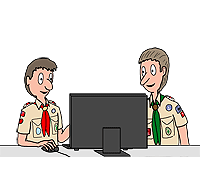
CHEMISTRY
These were the REQUIREMENTS before the REVISIONS
made on January 1, 2005.
To see the current requirements
Click Here
- Define chemistry and tell what chemicals are.
- Make a list of 10 chemicals found in your home and their
use.
- Tell how chemicals in your home are safely stored and
how to dispose of them safely.
- Tell the difference between a chemical reaction and
a physical change.
- Tell what analytic chemists do. Do THREE of the following:
- Prepare an indicator from a plant leaf or bloom. Show
that it works when vinegar neutralizes baking soda solution.
- Compare the strengths of 5 percent solutions of baking
soda and borax by titrating each with vinegar.
- Test two different bits of food for starch and protein.
- Compare the amounts of vitamin C in two kinds of fruit
juice.
- Show that ink or food color has two or more colors by
using paper chromatography.
- Define biochemistry.
- Write a simple equation for photosynthesis. Explain
what parts sunlight and chlorophyll play in it. Give the
three main parts of a 10-6-4 fertilizer. Explain what each
one does for plants. Draw from memory a sketch of the carbon
dioxide oxygen cycle.
- Explain what oxygen does in the animal body. Describe
how oxygen, carbon dioxide, and carbon monoxide are carried
in the body. Describe the chemical changes taking place
when: vegetables cook meat cooks bread dough rises bread
bakes bread is chewed.
- Define inorganic chemistry. Carry out an experiment to show
three different ways of protecting iron or steel from rusting.
Tell why aluminum doesn't rust the way iron does. Do an experiment
in which one metal makes another metal deposit from solution.
Explain what takes place in terms of the activity series of
metals.
- Define organic chemistry.
- What are organic chemicals?
- Name three organic chemicals.
- Tell the difference between polar and nonpolar.
- Show how polar and nonpolar substances do not mix.
- Define physical chemistry.
- Construct a Cartesian diver.
- Explain why the medicine dropper sinks to the bottom
when the sides are squeezed.
-
- Name two chemicals that cause air, water, or solid waste
pollution near your home. Tell where these pollutants might
have come from. Find one way to control one of these. Do
one test to show that air or water is polluted.
- Do ONE of the following:
- Write the formula for ozone. Tell where it is found.
Tell how it is both a pollutant and also necessary for
a healthy environment.
- Write the formula for carbon dioxide. How can it
cause the greenhouse effect?
- Write the formula for sulfur dioxide. Explain what
acid rain is. What does pH measure? Measure the pH of
rain or a body of water near your home. Tell how acid
rain can be prevented.
- Do ONE of the following:
- Visit an industrial plant that makes chemical products
or uses chemical processes, and describe the processes used.
What, if any, pollutants are produced? How are they handled?
- Visit a laboratory or business that uses chemicals and
find out how and why chemicals are used.
- Visit a county agent to learn how chemistry is meeting
farm problems of soil fertility and crop pests.
- Describe two different kinds of work done by chemists, chemical
engineers, and chemical technicians. Explain the differences
in college courses for training each of these three kinds of
people.
BSA Advancement ID#: 34
Pamphlet Revision Date: 1998
Requirements last updated 1991
|





